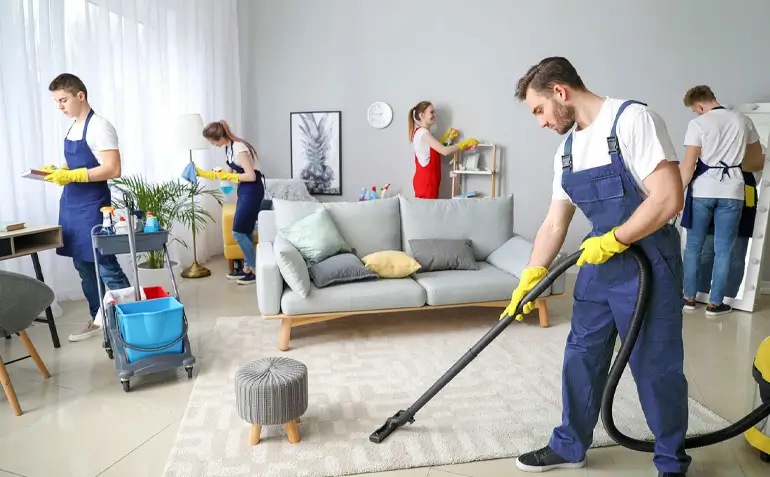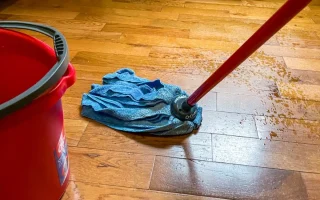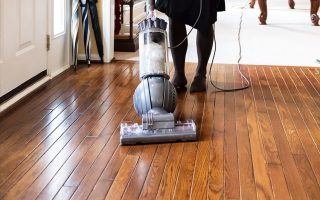Think your home is spotless? Think again. The appearance of clean countertops and freshly vacuumed floors hides hidden grime, which people normally overlook during cleaning. That dust bunny under the couch? The sticky buildup in your dishwasher? Bacteria, together with allergens and dirt, quietly accumulate in these spaces before they show up.
Most thorough cleaning efforts fail to reach important areas that affect both air quality and hygiene standards. Such forgotten areas in your home create conditions for dust accumulation, mold growth, and germ spread, which results in an unpleasant smell. You do not need to dedicate numerous hours to manual scrubbing throughout your entire house.
The following guide presents seven essential deep cleaning jobs that should be included in your deep cleaning plan because hidden areas matter as much as visible ones do when it comes to home cleanliness.
7 Overlooked Tasks to Add to Your Deep Cleaning Checklist
1. Cleaning Behind and Under Large Appliances
People generally follow an “out of sight, out of mind” approach when they neglect cleaning areas behind and underneath major household appliances. The exterior of your fridge, oven, and washing machine appears clean, but their hidden spaces remain unclean. That’s another story.
These concealed spaces become ideal habitats for pests and bacteria while attracting bad odors because they trap grease, crumbs, dust, and lost utensils.
The main reason people avoid this cleaning task is because it causes inconvenience. The process of moving heavy appliances takes time and homeowners typically do not worry about hidden debris unless there are smell issues or appliance malfunctions. A small amount of work dedicated to this area will deliver major benefits for hygiene standards and appliance performance.
Start by moving appliances forward with care by using furniture sliders or gently rocking the appliance from side to side. After making the area accessible you should vacuum dust and debris before using a baking soda and vinegar solution to clean away sticky residue and grease. The refrigerator coils need your attention because excessive dust causes the appliance to function harder thus using more energy.
For those who prefer professional help, house cleaning services in Houston can assist with deep cleaning tasks like these, ensuring that hard-to-reach spaces are thoroughly cleaned and sanitized.
Surface tidiness through regular cleaning meets deep cleaning requirements, which ensure sanitary and pest-free conditions for all areas. Cleaning your kitchen appliances and laundry space should be performed every 3–6 months to minimize dust buildup and extend appliance life while maintaining a fresh environment.
2. Light Switches, Doorknobs, and Handles
You perform these actions countless times throughout each day as you switch lights on and off and twist door handles and open cabinet doors. Consider the last occasion when you conducted proper cleaning of these items. Exactly. These frequently touched surfaces build layers of bacteria along with dirt and oil from human interaction yet cleaning staff infrequently include them on their cleaning routines.
Light switches and doorknobs remain unnoticeable for their lack of visible dirt which leads to their frequent neglect. Research indicates high-touch surfaces accumulate more germs than a toilet seat which makes them significant carriers of diseases particularly when flu season arrives.
Rapid cleaning remains essential for these items. A disinfectant wipe or a microfiber cloth that has vinegar and water solution is sufficient for regular cleaning tasks. A cotton swab soaked with rubbing alcohol serves as an effective solution for cleaning hard-to-reach areas by the edges. Brass and metal handles require a gentle solution of soap water since harsh chemicals can cause tarnishing and corrosion.
Regular cleaning of these surfaces should be performed at least once per week yet the frequency rises when cold and flu season arrives. The simplest method to stop germ spread exists in maintaining cleanliness of commonly touched spots because everyone wants germ-free door handles.
3. Air Vents and HVAC Filters
Dust on your furniture persists despite regular cleaning because your air vents serve as hidden dust collectors. Your HVAC system sends dust along with pet dander and allergens back into the air when it operates because these elements accumulate in your air vents. The accumulation that looks harmless may be causing both air quality issues and health problems inside your home.
The ongoing clogging of HVAC filters causes your system to labor more intensely as it distributes dust and pollen together with airborne pollutants throughout your living space. When HVAC filters go without maintenance they become less efficient and at the same time create an environment where mold spores and bacteria can thrive which leads to worsened allergy symptoms and respiratory problems.
A clean home environment depends on removing vent covers followed by vacuuming the interior with a brush attachment. Warm soapy water should be used to soak the covers before complete drying takes place before reinstalling. The lifespan of HVAC filters depends on your household requirements and should be replaced every 1–3 months.
People who have respiratory conditions or allergies in their home should increase the frequency of filter changes and vent cleaning.
All HVAC maintenance operations require the system to be powered off at the thermostat or circuit breaker to prevent accidents. Maintaining your HVAC system through regular vent cleaning twice per year and proper filter replacement creates immediate improvements in air quality that result in better breathing conditions.
4. Ceiling Fans and Light Fixtures
A diary of your ceiling fan would most likely record its monthly neglect by humans. Home fixtures operate without rest to provide cooling and lighting, but typically remain off the deep cleaning schedule. Dust avalanches typically lead to visible contamination on your furniture or the unfortunate contamination of your coffee.
The actual problem goes beyond visible dust because each fan rotation sends airborne particles throughout the room. When fans remain unattended they distribute allergens and dust throughout the air which harms air quality while making your cooling system operate at higher capacity. Light fixtures in kitchen areas accumulate grime and bugs and grease which darkens your home environment gradually.
Dust fan blades effectively by using a microfiber duster or an old pillowcase which will catch the dust without creating disorder. You should take out glass covers from light fixtures before washing them with warm water mixed with soap to make them shine again.
Regular cleaning of your fans once every 1–2 months will maintain their proper operation, increase light brightness, and prevent dust accumulation in your home.
5. Inside Kitchen Sink and Garbage Disposal
The busiest spot in your house is your kitchen sink because it handles all tasks, including vegetable rinsing and dish scrubbing. People use their kitchen sink constantly but often miss the hidden substances, including food debris and bacteria, along with a garbage disposal that could easily develop into science experiments for bad odors.
Homeowners tend to believe their sinks remain clean since water consistently runs through them. The surface and drain and disposal accumulate soap scum and grease buildup and food residue which allows bacteria and unpleasant odors to develop gradually. The unpleasant odor near your sink indicates your garbage disposal needs immediate care.
Begin by applying baking soda to the sink surface, then clean it with a wet sponge to achieve a fresher and cleaner result. Heating water will help you remove dirt particles after you have scrubbed the surface. The drain requires half a cup of white vinegar, which should stay in position for 15 minutes to break down clogs and eliminate odors.
A mixture of ice cubes and lemon slices introduced to the garbage disposal will help break loose debris while sharpening blades, creating a pleasant citrus fragrance.
Deep sink cleaning should become a regular weekly task, and you should service your garbage disposal every two weeks to avoid your kitchen smelling like yesterday’s food waste.
6. Underneath and Inside Furniture
The hidden areas under and behind your furniture contain more dust and debris than you can see from the surface.
That cozy armchair? The items you sit on are probably covered by a mix of dust, pet hair, and forgotten crumbs. And that dresser against the wall? The area underneath the furniture contains both cobwebs and unused items. Areas beneath furniture normally remain untouched by daily cleaning, so they accumulate dirt until allergies become noticeable or during unexpected deep cleaning, when the hidden mess becomes apparent.
Areas that receive no attention have a double impact on both visual appearance and indoor air quality and cleanliness standards. People with allergies or asthma face air quality degradation when walking by furniture because dust that remains trapped under beds and sofas gets lifted into the air. The legs, along with the backs and undersides of furniture, accumulate grime that remains hidden, which turns into a bacterial breeding site and produces musty odors as time passes.
Using an extension hose attached to a vacuum will help prevent dust and allergens from accumulating. You should move your furniture once every 2–3 months to sweep or mop underneath it so hidden dirt does not stay hidden for years.
A damp cloth should be used to wipe down furniture legs, backs, and undersides because this method removes dust from hard surfaces. The deep cleaning process must include freshening up forgotten bedding items such as duvet covers and dust ruffles, together with throw pillowcases.
If you let these areas go unchecked, they become concealed dust collection points, which no one should face upon rearranging their couch.
7. Washing Machine and Dishwasher Interior
Your washing machine and dishwasher maintain cleanliness in your home, yet how long has it been since you cleaned them?
The performance of neglected appliances declines because soap scum together with mold and food residue accumulate during periods of neglect creating bad smells and reduced functionality. The presence of a strange film on your dishes, together with a musty smell in your laundry, signals that your machine requires maintenance.
Water and detergent used in both appliances create conditions where mildew, along with bacteria and grime, can thrive. Mold spores from a dirty washing machine drum or rubber seal will contaminate your laundry, but your dishwasher becomes ineffective when it gets clogged with food particles, thus leaving food residue on your dishes. The problems you ignore will damage both your hygiene standards and reduce the operational lifespan of your appliances.
Regular maintenance of your washing machine involves running an empty hot water cycle with vinegar to eliminate accumulated residue. Regular cleaning of the rubber seal and detergent tray is essential because mold prefers to reside in these areas.
You must remove and wash the dishwasher filter to eliminate food trapped inside. Regular cleaning cycles using vinegar and baking soda will maintain your appliances’ deodorizing power while preventing malfunctions.
Conclusion
A neat countertop combined with vacuumed floors gives your home an appearance of cleanliness, yet you cannot see the dust and germs that remain hidden under furniture, inside appliances, and attached to ceiling fan blades. A superficial cleaning effort fails to address the deeper issues because dust bacteria and buildup steadily accumulate in areas that people tend to forget.
Your weekly cleaning routine will become more effective when you incorporate these seven hidden deep cleaning tasks, which will enhance both your environment’s health and the durability of your appliances, together with household furniture. Knowing standard cleaning from deep cleaning enables you to reach all the most neglected areas in your home that need thorough attention.
Deep cleaning tasks executed on a regular basis stop allergens from dominating the environment, eliminate odors, and improve home air quality, transforming maintenance work into an essential home practice. Everyone agrees that finding hidden dust bunnies under furniture or unidentified odors from the garbage disposal would be unpleasant discoveries.




